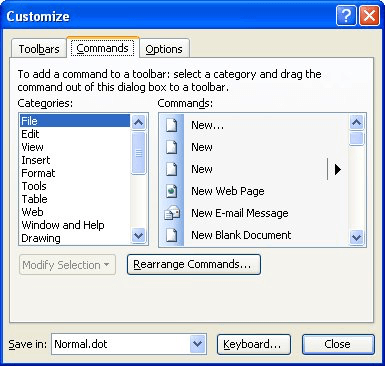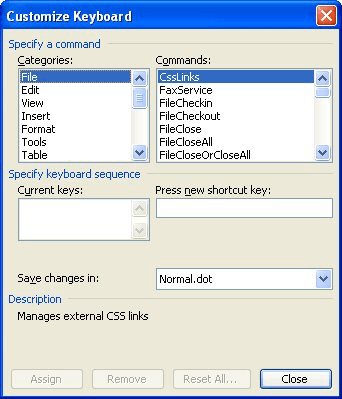Please Note: This article is written for users of the following Microsoft Word versions: 97, 2000, 2002, and 2003. If you are using a later version (Word 2007 or later), this tip may not work for you. For a version of this tip written specifically for later versions of Word, click here: Stepping through Sentences.
Written by Allen Wyatt (last updated May 10, 2022)
This tip applies to Word 97, 2000, 2002, and 2003
Word does not provide function keys for you to step through your document one sentence at a time. If you are used to a different word processor, you may consider such a capability rather important. The following macro, StepRightSentence, provides the capability to step through a document one sentence at a time toward the right. You can assign the macro either to a shortcut key or to a toolbar button.
Sub StepRightSentence()
If Selection.Type <> wdNoSelection Then
Selection.MoveRight Unit:=wdCharacter, Count:=1, Extend:=wdMove
End If
Selection.Sentences(1).Next(Unit:=wdSentence, Count:=1).Select
End Sub
If you want to use Word to step through a document toward the left (beginning of the document), you can use the following macro, StepLeftSentence:
Sub StepLeftSentence()
If Selection.Type <> wdNoSelection Then
Selection.MoveLeft Unit:=wdCharacter, Count:=1, Extend:=wdMove
End If
Selection.Sentences(1).Previous(Unit:=wdSentence, Count:=1).Select
End Sub
Regardless of which of these macros you use, the result is that you step through your document, one sentence at a time. After running the macro, the next sentence—left or right—is selected. If you instead want to only jump to the beginning of the sentence, without selecting it, add the following line as the final line in the macro, just before the End Sub statement:
Selection.Collapse Direction:=wdCollapseStart
If you prefer to not use macros, you can also move through sentences by customizing Word to take advantage of some "hidden" commands. Follow these steps:

Figure 1. The Customize dialog box.

Figure 2. The Customize Keyboard dialog box.
After performing this series of steps, you can step backwards through your document, one sentence at a time, simply by pressing Alt+Left Arrow. You can also repeat the steps and assign the following
| Action | Commands List | Shortcut Key | ||
|---|---|---|---|---|
| Step right by sentences | SentRight | Alt+Right Arrow | ||
| Step left and select | SentLeftExtend | Shift+Alt+Left Arrow | ||
| Step right and select | SentRightExtend | Shift+Alt+Right Arrow |
Most Word users will find these keyboard commands a welcome addition to the normal editing keys. You should know, however, that some of these suggested shortcut keys are already in use by Word. For instance, the Shift+Alt+Left Arrow combination is used to promote a heading level in an outline. However, if you can live without that use of the keys, then go for it. (Personally, I think this reassigned use makes much more sense.) If you would rather use a different key combination, you can do so by using any one you would like in step 6 above.
Note:
WordTips is your source for cost-effective Microsoft Word training. (Microsoft Word is the most popular word processing software in the world.) This tip (979) applies to Microsoft Word 97, 2000, 2002, and 2003. You can find a version of this tip for the ribbon interface of Word (Word 2007 and later) here: Stepping through Sentences.

The First and Last Word on Word! Bestselling For Dummies author Dan Gookin puts his usual fun and friendly candor back to work to show you how to navigate Word 2019. Spend more time working and less time trying to figure it all out! Check out Word 2019 For Dummies today!
Want a really quick way to select text? Just combine the Shift key with a simple mouse click.
Discover MoreWant a quick way to select your entire document without taking your hand off of the mouse? Try clicking away using the ...
Discover MoreNeed to select an entire sentence? It's easy by making one small adjustment to how you click the mouse.
Discover MoreFREE SERVICE: Get tips like this every week in WordTips, a free productivity newsletter. Enter your address and click "Subscribe."
2017-04-09 12:59:50
Craig
While implementing this tip I found Shift-Alt-Left Arrow is normally assigned to Outline Promote and Right Arrow assigned to Outline Demote. I would prefer to keep those shortcuts, know that I know about them. Unassigned alternates available to use for selecting the previous / next sentence are Shift-Ctrl-Left Arrow and Shift-Ctrl-Right Arrow.
Got a version of Word that uses the menu interface (Word 97, Word 2000, Word 2002, or Word 2003)? This site is for you! If you use a later version of Word, visit our WordTips site focusing on the ribbon interface.
Visit the WordTips channel on YouTube
FREE SERVICE: Get tips like this every week in WordTips, a free productivity newsletter. Enter your address and click "Subscribe."
Copyright © 2026 Sharon Parq Associates, Inc.
Comments